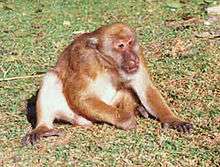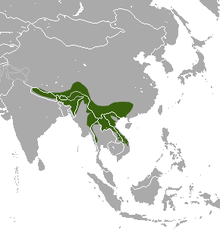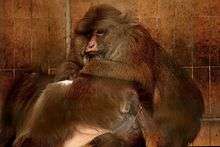Assam macaque
The Assam macaque or Assamese macaque (Macaca assamensis) is a macaque of the Old World monkey family native to South and Southeast Asia. Since 2008, the species has been listed as "near threatened" by the IUCN, as it is experiencing significant declines due to hunting, habitat degradation, and fragmentation.[1]
| Assam macaque | |
|---|---|
 | |
| Scientific classification | |
| Kingdom: | Animalia |
| Phylum: | Chordata |
| Class: | Mammalia |
| Order: | Primates |
| Suborder: | Haplorhini |
| Infraorder: | Simiiformes |
| Family: | Cercopithecidae |
| Genus: | Macaca |
| Species: | M. assamensis[2] |
| Binomial name | |
| Macaca assamensis[2] McClelland, 1840 | |
 | |
| Assam macaque range | |
Characteristics
The Assam macaque has a yellowish-grey to dark brown pelage. The facial skin is dark brownish to purplish. The head has a dark fringe of hair on the cheeks directed backwards to the ears. The hair on the crown is parted in the middle. The shoulders, head and arms tend to be paler than the hindquarters, which are greyish. The tail is well-haired and short. Head-to-body-length measures 51 to 73.5 cm (20.1 to 28.9 in), and the tail is 15 to 30 cm (5.9 to 11.8 in) long. Adult weight is 5 to 10 kg (11 to 22 lb).[3]
Distribution and habitat

The Macaca assamensis "Nepal population" is endemic to Nepal and likely in some way distinct from the two recognized subspecies, which occupy adjacent areas to the southeast and east of the range of M. assamensis. There is a gap in northeastern India between the two main population pockets, specifically between central Bhutan and the south side of the Brahmaputra River; the east bank of its upper course marks the division between the two recognized subspecies:[4]
- The eastern Assamese macaque, M. a. assamensis, occurs in Bhutan, Arunachal Pradesh, Assam, Manipur, Meghalaya, Mizoram, Nagaland, Sikkim, and Tripura in northeastern India, into northern Myanmar, southeast through the Myanmar-Thailand border ranges as far as Chongkrong, to the upper Mekong in Tibet, into the provinces of Guangxi, Guizhou, Tibet and Yunnan in southwestern China, in Thateng in northern Laos, and Hoi Xuan in northern Vietnam;
- The western Assamese macaque, M. a. pelops, is found from central Nepal through Uttar Pradesh, Sikkim, Assam and northernmost West Bengal in northern India, into central Bhutan and the Sundarbans in Bangladesh.
During surveys carried out in 1976, 1978, and 1984 in Nepal, Assam macaques were found to be patchily distributed along rivers in tropical and subtropical forests at altitudes from 200 to 1,800 metres (660 to 5,910 ft). They are apparently absent from areas west of the Kaligandaki River.[5] In India, they live in tropical and subtropical semievergreen forests, dry deciduous and montane forests, from the sea level to altitudes of 4,000 metres (13,000 ft).[6] They usually inhabit hill areas above 1,000 m (3,300 ft), but in the wetter east they may occur even in the lowlands, and frequent areas that only marginally reach this altitude. In Laos and Vietnam, they prefer high altitudes, usually above 500 m (1,600 ft). In forests on limestone karst, they occur in much lower elevations.[1]
Ecology and behaviour
Assam macaques are diurnal, and at times both arboreal and terrestrial. They are omnivorous and feed on fruits, leaves, invertebrates and cereals.[1] In Namdapha National Park, Arunachal Pradesh, 15 groups were recorded in 2002 comprising 209 individuals. The population had a group density of 1.11 individuals per 1 km2 (0.39 sq mi), and an average group size of 13.93 individuals.[7] During a survey in Nepal's Langtang National Park in 2007, a total of 213 Assamese macaques were encountered in 9 groups in the study area of 113 km2 (44 sq mi). Troop sizes varied between 13 and 35 individuals, with a mean troop size of 23.66 individuals, and comprised 31% adult females, 16% adult males, and their young of various ages. They preferred maize kernals, followed by potato tubers, but also raided fields with wheat, buckwheat, and millet.[8]
Threats
The threats to this species' habitat include selective logging and various forms of anthropogenic development and activities, alien invasives, hunting and trapping for sport, medicine, food, and the pet trade. Additionally, hybridization with adjacent species poses a threat to some populations.[9]
Conservation
Macaca assamensis is listed in CITES Appendix II. It is legally protected in all countries of occurrence. For the populations in India, the species is listed under Schedule II, part I of the Indian Wildlife Act.[7]
References
| Wikispecies has information related to Assam Macaque |
- Boonratana, R.; Chalise, M.; Das, J.; Htun, S. & Timmins, R. J. (2008). "Macaca assamensis". IUCN Red List of Threatened Species. 2008: e.T12549A3354977.
- Groves, C. P. (2005). Wilson, D. E.; Reeder, D. M. (eds.). Mammal Species of the World: A Taxonomic and Geographic Reference (3rd ed.). Baltimore: Johns Hopkins University Press. p. 161. ISBN 0-801-88221-4. OCLC 62265494.
- Françis, C. M. (2008) A field guide to the mammals of South-East Asia. New Holland Publishers. ISBN 1-84537-735-4
- Groves, C. P. (2001) Primate taxonomy. Smithsonian Institution Press, Washington, DC, USA.
- Wada, K. (2005) The distribution pattern of rhesus and Assamese monkeys in Nepal. Primates (2005) 46:115–119.
- Srivastava, A. and Mohnot, S. M. (2001) Distribution, conservation status and priorities for primates in Northeast India Archived July 21, 2011, at the Wayback Machine. ENVIS Bulletin: Wildlife and Protected Areas 1(1): 102–108.
- Chetry, D., Medhi, R., Biswas, J., Das, D. and Bhattacharjee, P. C. (2003). Nonhuman primates in the Namdapha National Park, Arunachal Pradesh, India. International Journal of Primatology 24(2): 383–388.
- Regmi, G. R., Kandel, K. (2008). Population Status, Threats and Conservation Measures of Assamese macaque (Macaca assamensis) in Langtang National Park, Nepal. A final report submitted to Primate Society of Great Britain, UK.
- Molur, S., Brandon-Jones, D., Dittus, W., Eudey, A., Kumar, A., Singh, M., Feeroz, M. M., Chalise, M., Priya, P. and Walker, S. (2003). Status of South Asian Primates: Conservation Assessment and Management Plan Report Archived 2016-12-21 at the Wayback Machine. Workshop Report, 2003. Zoo Outreach Organization/CBSG-South Asia, Coimbatore, India.

_male_head_Nagarjun.jpg)